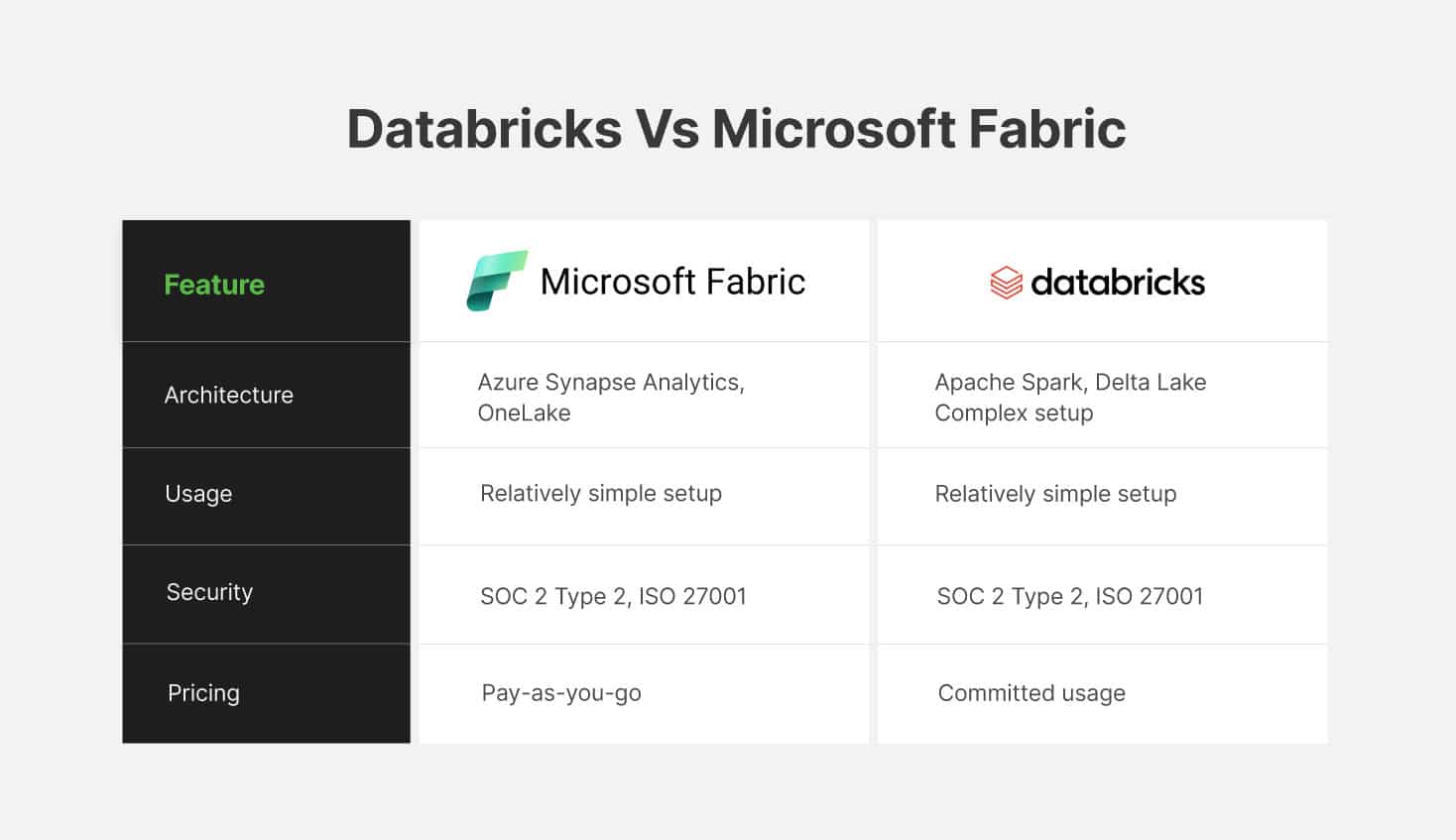For years, Databricks has enabled organizations to work with all types of data, structure and unstructured, within a unified, user-friendly environment. Databricks has empowered enterprises to streamline their data workflows, accelerate insights generation, and drive innovation. In fact, over 7,000 organizations, regardless of their sizes, have been using Databricks for data engineering, advanced analytics, and data science.
However, in this evolving landscape of AI and data analytics platform services, Microsoft Fabric has emerged as a significant development, offering enterprises another all-in-one platform for their data analytics needs. Fabric provides a similar, unified solution that brings together experiences including Data warehouse, Data Science, Data Factory, Data Engineering, Real-time Analytics and Power BI into a shared SaaS foundation.
With Microsoft announcing Fabric as a robust data management and analytics solution, the question that has made everyone curious is whether they need to switch to Fabric or rely on Databricks if both serve the same purpose.
This blog will address these concerns and demonstrate how these technologies can optimize your organization’s data analytics needs.
What is Databricks?
Databricks is an open and unified analytics platform for Big Data processing, engineering, data science, and Machine Learning. It offers a robust and scalable environment built on top of Apache Spark, a powerful open-source engine for large-scale data processing. This analytics platform also provides unified data governance, security, and data sharing capabilities.
Databricks offers a cloud-agnostic approach and provides a powerful and faster environment for processing large volumes of data, running machine learning algorithms, and generating real-time insights. Databricks is supported on all three leading cloud providers, AWS, Azure, and GCP.
The Databricks workspace provides a unified experience for various data solutions, such as:
- Data processing scheduling and management, in particular ETL, and ELT
- Data discovery, annotation, and exploration
- Managing security, governance, high availability, and disaster recovery
- Generating dashboards and visualizations
- Machine learning (ML) modeling, tracking, and model serving
- Generative AI solutions
What is Microsoft Fabric?
Fabric, released by Microsoft in May 2023, is an advanced all-in-one analytics platform that brings together data, analytics, ML, and AI tools into a unified SaaS offering. This platform offers different user persona experiences, such as Data Engineering, Data Factory, Data Science, Data Warehouse, Real-Time Analytics, and Power BI, that eliminate the hassle of managing different tools and platforms.
Microsoft Fabric is a suite of highly integrated analytic tools and services designed to foster collaboration, and help organizations manage their data and AI journey from start to end.
Discover the real-time analytics capabilities of Synapse within the Microsoft Fabric ecosystem here.
Will Microsoft Fabric bring an end to Databricks?
Since both Databricks and Microsoft Fabric are advertised as unified data analytics platforms, businesses are in the state of questioning whether they should opt for Databricks or the new Microsoft Fabric platform.
It is highly unlikely that Fabric will fully replace Databricks as they both serve similar purposes within the analytics landscape. Databricks is a very mature, widely adopted platform in use by over 7,000 customers.
Microsoft Fabric is a solid choice for organizations needing a unified environment for data engineering, Machine Learning, and BI. Fabric operates and is supported in Microsoft Azure. Fabric also supports the use of storage and data across all three major cloud providers (AWS, Azure, and GCP).
If your focus revolves around an open platform that excels in providing Spark notebooks, Big Data processing and machine learning with optimized Apache Spark performance, Databricks is a great platform. Databricks is supported in all three major cloud platforms (AWS, Azure, and GCP). If your organization has adopted Databricks, then a full migration is not an attractive business case.
Microsoft Fabric comes with OneLake, an open and unified SaaS data lake for centralized organizational storage. OneLake offers a unified location to store all organizational data. Businesses looking to acquire the capabilities of Fabric and Databricks can simply leverage Fabric OneLake shortcut, allowing data usage where it resides without the need to copy or move it. Databricks offer similar functionality allowing organizations to connect data and storage across cloud providers like Azure and OneLake.
Businesses can create shortcuts for data within OneLake or external lakes like Azure Data Lake Storage Gen2 or Amazon S3. So essentially, businesses can access OneLake data in either of two ways:
- Use OneLake with existing Data Lakes
- Use data landed in OneLake directly
Databricks and Fabric complement each other, offering a full range of advanced analytics and AI solutions when used in conjunction. If your organization is just beginning to adopt analytics tools, you should evaluate Fabric and Databricks equally.











